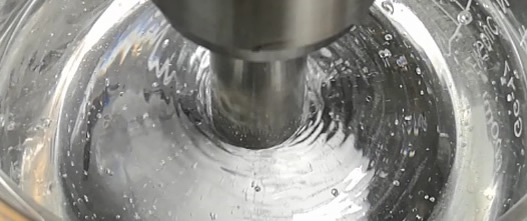|
|
|
|
|
|
Ultrasonic Sonicator for Degassing & Defoaming |
|
|
04 Feb, 2016 |
Ultrasonic Processor |
|
|
|

Ultrasonic sonicator has been applied in a broad range of applications such as degassing and defoaming for molten metals, epoxy resin, canned food, drinks, etc. The high-density sonication radiated from ultrasonic probe can effectively remove the dissolved gases from the liquid media in a short period of time.
The degassing process of ultrasonic probe sonicator
In general conditions, there is a certain number of dissolved gas in the liquid and form a state of equilibrium level, the concentration of gas may be affected by many factors including atmospheric pressure, agitating strength and temperature. Ultrasonic degassing can break the equilibrium state and reduce the gas concentration in the solution.
Via the oscillation generated by radiating surface of sonicator, the ultrasound wave is propagated into the fluid and generates a large number of small vacuum bubbles which are widely distributed in the liquid. Due to the increase in bubble volume, the pressure within the bubble is gradually decreased, and the dissolved gas tend to diffuse into the inflated bubble from surrounding solution until the cavitation bubble has reached its limit. Conversely, when the bubble begin to shrinking, the gas within bubble will diffuse back into the solution. Because the time is very short, there are still a lot of gases rise to the surface of the liquid together with bubbles. The whole process occurs as a repeated cycle and ultimately the degassing work is accomplished successfully.
On the other hand, the rapid process of sonication greatly reduces the contact time between the small bubbles and the fluid level. That means it's hard for gas to re-dissolve from the vacuum bubble to the fluid. This has important significance to degassing result especially for the fluids with higher viscosity e.g. epoxy resin or silicone oil.
Applications of ultrasonic sonicator in degassing treatment
Degassing and defoaming by probe sonicators is required for multiple purposes of liquid treatments. Below, we will see about some of the most popular applications:
1) Degassing before Ultrasonic Cleaning
As we know, ultrasonic cleaning depends on the collapse of innumerable cavitation bubbles to achieve a favorable cleaning effect. Even so, the gas dissolved in cleaning solution diffuses into bubbles and dampen the process of implosion action, further to reduce the effectiveness of sonic cleaning. The reason is that the gas within bubbles produce a cushioning effect on collapsing, just like to compress a football being inflated.
Degassing is necessary procedure for the removal of dissolved gasses from liquid in an ultrasonic tank. The dissolved gas may migrate into these cavitation bubbles and accelerate the growth of the bubbles. Through the action of acoustic waves, the suspended bubbles are rised to the surface of liquid and then release the gas into air. Generally, the dissolved gasses within the cleaning solution can be removed in a few minutes.
2) Degassing and deforming for food industry
Some liquid foods including cola, wine, soda and beer, etc, have a high concentration of dissolved gas e.g. CO2. The ultrasound wave can greatly accelerate the process of degassing and force the gas bubbles to rise to the surface constantly. Unlike the ultrasonic bath, ultrasonic sonicator is usually designed as bar sonotrode which can be integrated in the bottling or filling equipment. The benifit is that there is no worry about the bottles or cans get wet. More serious, immersion of the containers into a tank may cause the leakage problem i.e. the beverage mixed into the water and contaminate.
With the help of airborne ultrasonic technology, defoaming for carbonated beverages is another important application in food industry. The large amounts of foams produced by fermentation process result in an unfavorable influence on both quality and production. The ultrasonic probe sonicator with unique design can emit high-intensity ultrasonic waves in the air which effectively destroy the foam bubbles without touching the solution. Different from conventional methods such as addition of anti-foaming chemical agents and other mechanical breakers, ultrasonic sonicator is definitely a green and efficient procedure to defoam bubbles.
Factors affecting the ultrasonic degassing effect
1) The impact of sonicating conditions
Increased temperature helps to reduce the viscosity of the fluid medium, and further to improve the cavitation effect for ultrasonic degassing, yet the higher temperature may lead to a higher vapor pressure which can make up the gas concentration. After all things considered, we should find a balance to determine the optimal temperature for sonication. Of course, if the solution isn't exposed to any gas i.e. a gas pump is applied to form the vacuum above the liquid surface, heating the solution is a good method.
2) Influence on design of ultrasonic sonicator and container
First, to prevent the solution getting turbulent by controlling the amplitude of sonicator and agitation. The probe of ultrasonic sonicator with larger surface is beneficial to generate cavitation bubbles in a more extensive area. It means that the more gases can be trapped into the bubbles to obtain a better degassing effect. Other than that, in order to prevent the re-dissolving of gases from bubbles to the solution, the shallow tank or container will be conducive to reduce the time to the liquid surface.
|
|
|
« Back |
|
↑ Top |
|
|
|
|
 Downloads
Downloads Sitemap
Sitemap Downloads
Downloads Sitemap
Sitemap